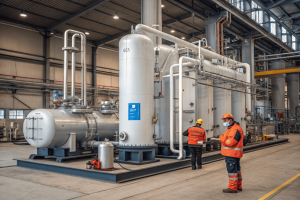How does sustainable CO2 recycling contribute to the circular economy model?
•
How does sustainable CO2 recycling contribute to the circular economy model?
Your business produces CO₂ as waste, a linear path to pollution. The circular economy seems out of reach. CO₂ recycling closes this loop, turning your waste into a valuable resource.
Sustainable CO₂ recycling contributes by transforming a waste gas into a valuable feedstock for other industries. This creates a closed-loop system where carbon is reused, reducing the need for new fossil-fuel-based CO₂ and minimizing overall emissions.
I've seen a real shift in how companies view their emissions. It's no longer just about disposal. It's about opportunity. The concept of a circular economy is becoming a powerful business driver, pushing industries to rethink what they once considered waste. This new mindset is where CO₂ recycling truly begins to shine. We are helping our clients move from a "take-make-waste" model to a "recover-recycle-reuse" one.
What is the environmental benefit of displacing virgin CO₂ production with recovered CO₂?
Your supply chain uses CO₂, but it's produced by burning more fossil fuels. This adds new carbon to the atmosphere. Recovered CO₂ provides a cleaner alternative, but what's the tangible benefit?
The main benefit is avoiding "new" emissions. Virgin CO₂ is often produced by burning fossil fuels specifically for that purpose. Using recovered CO₂ from an existing industrial source prevents these extra emissions, lowering the carbon footprint for the end product.

The distinction between "virgin" and "recovered" CO₂ is critical. In my work, I help clients understand this difference because it has a huge impact on their sustainability goals. Virgin CO₂ is typically made as a primary product. For example, some facilities burn natural gas in a boiler just to create a CO₂-rich flue gas, which they then capture. This process is energy-intensive and introduces new carbon into the atmosphere.
In contrast, recovered CO₂ comes from a source that was going to emit it anyway, like a brewery's fermentation tanks or a cement kiln. By capturing this "waste" CO₂, we are simply recycling carbon that is already part of an existing industrial cycle. Every ton of recovered CO₂ that a beverage company buys from a brewery is one ton that didn't have to be newly created by burning fossil fuels. This simple act of displacement is a direct and measurable environmental victory.
| CO₂ Source | Origin of Carbon | Environmental Impact |
|---|---|---|
| Virgin CO₂ | Newly burned fossil fuels | Adds new CO₂ to the atmosphere. |
| Recovered CO₂ | Recycled from existing process | Prevents emissions; avoids virgin CO₂ production. |
How do regional carbon taxes or cap-and-trade schemes incentivize the installation of CO₂ recovery systems?
Carbon taxes are rising, cutting into your profits. You see it as just another cost. But what if this policy could actually fund your next capital project and reduce your operational expenses?
These schemes create a direct financial penalty for emitting CO₂. Installing a recovery system allows a company to avoid paying that tax or buying expensive carbon credits. This cost avoidance acts as a powerful incentive, often making the investment in capture technology profitable.

I worked with a cement plant in a region that introduced a $50/ton carbon tax. Their annual emissions cost was going to be millions of dollars. The decision to emit was no longer free. This changed everything. We designed a capture system for their facility. The math was straightforward: the investment in our equipment would be paid back in under five years, based on the tax savings alone. The carbon tax turned a pollution problem into a clear business case for a capital project.
These policies work in two main ways:
- Carbon Tax: This is a direct fee on emissions. If you capture 10,000 tons of CO₂, you avoid paying the tax on those 10,000 tons. It's a simple, powerful motivator.
- Cap-and-Trade: The government sets a "cap" on total emissions and gives companies allowances. If you capture your CO₂ and emit less, you don't need all your allowances. You can then sell your extra allowances to companies that are over their limit. This creates a new revenue stream.
Both systems make emitting CO₂ expensive, which fundamentally changes the economic calculation for investing in recovery technology.
What are the regulatory hurdles or permitting challenges for establishing a new CO₂ transport pipeline?
You've captured your CO₂, but you can't get it to market or storage. Building a pipeline seems impossible. The red tape and permitting process can stop a project before it even starts.
Major challenges include securing land rights-of-way across public and private lands, conducting extensive environmental impact assessments, and navigating complex safety regulations for high-pressure pipelines. The process involves multiple agencies, making it long and costly.

From my experience, the capture technology itself is often the most straightforward part of a large-scale project. We've had projects where the FTL Machine capture system was ready for fabrication in 18 months, but the pipeline permitting was projected to take over three years. Transport is a huge bottleneck.
The challenges fall into several key areas:
- Land Access (Right-of-Way): This is the biggest hurdle. A pipeline can cross hundreds of individual properties. You must negotiate with every single landowner, and if they refuse, it can lead to long legal battles over eminent domain.
- Environmental Impact Statements: In the U.S., a major pipeline triggers a review under the National Environmental Policy Act (NEPA). This requires years of study to assess the impact on ecosystems, wildlife, and water sources.
- Safety Regulations: CO₂ pipelines operate at very high pressures (over 2,000 psi). A rupture can be dangerous, as CO₂ is an asphyxiant. Federal agencies have very strict rules on pipeline materials, construction standards, and ongoing monitoring to ensure public safety. Navigating these layers of local, state, and federal bureaucracy requires a dedicated team and a lot of patience.
Conclusion
Sustainable CO₂ recycling is key to the circular economy. It prevents new emissions, is incentivized by carbon pricing, and, despite transport hurdles, turns a liability into a valuable, sustainable asset.
You may also be interested in:

Why is CO₂ recovery technology gaining popularity worldwide?
Why is CO₂ recovery technology gaining popularity worldwide? You see headlines about carbon capture everywhere. But you wonder if it's
Read more
How is a CO₂ recovery system designed to fit different industries?
How is a CO₂ recovery system designed to fit different industries? You're under pressure to implement a CO₂ recovery solution.
Read more
How energy-efficient are today’s CO₂ recovery technologies?
How energy-efficient are today’s CO₂ recovery technologies? You want to recover CO₂, but you fear that high electricity bills will
Read more